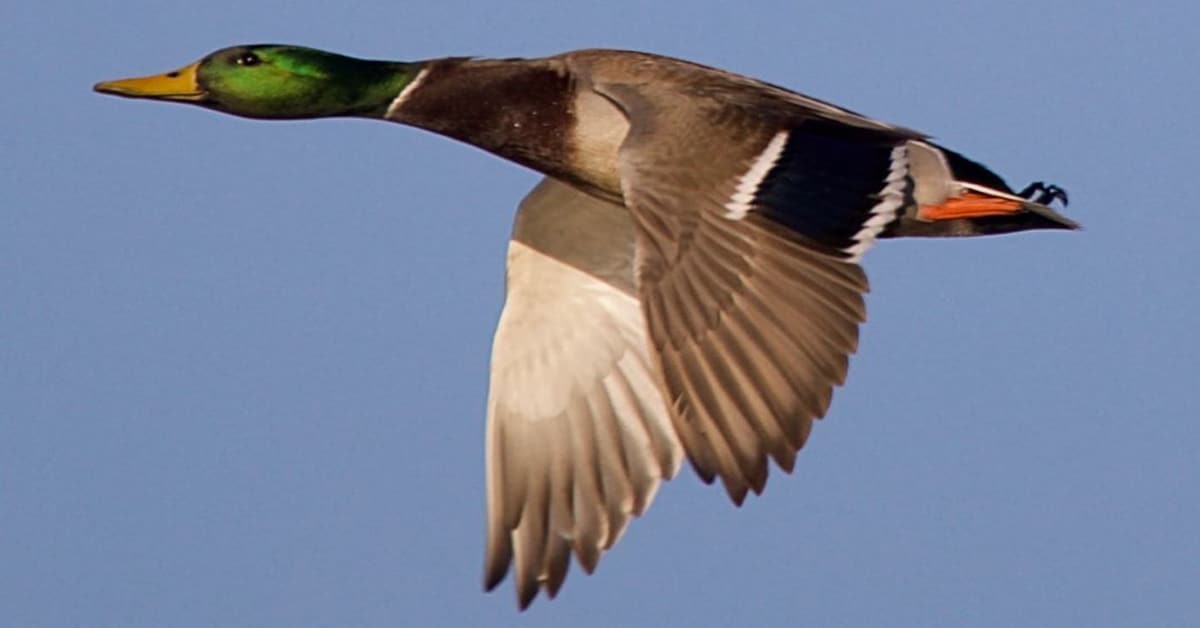Can Ducks Fly?
Who hasn’t heard of ducks, these quacky, cute creatures? They are widespread birds that live on every continent except Antarctica, and you’re probably very familiar with some species of them since they usually live among us. These fun-loving water birds are found in both freshwater and seawater. That’s why we see them mostly in the water or on land, but people still ask the question, “Can ducks fly?”
If you have some doubts that they can’t fly, it’s time for the truth. Even though some species can’t fly but glide, many species of duck are excellent flyers. Considering that ducks cannot survive freezing temperatures, they plan to spend the winter in warmer regions with plenty of food and little chance of freezing water. To stay alive, they need to travel, and flying is the key to their survival!
Keep on reading to find more interesting facts and information about the flight habits of our quacky friends.
Can All Species Of Ducks Fly?
Is it possible for all ducks to fly? Of course not! The flying ability of ducks depends on their body forms and wings. Some ducks are simply too heavy to fly, or their wings aren’t strong enough to keep them in the air.
For instance, duck species such as Pekin and Rouen are too fat to fly in the air. Even though all species of duck have wings, not all of them choose to fly and travel. So next time someone asks you, “Can ducks fly?” you know what the right answer is – it completely depends on the breed!
How can we distinguish between flying and non-flying species? Generally, most wild ducks can fly, and those that are domestic can mostly glide. You might wonder why this happens. Many breeds of domesticated ducks do not fly because they simply do not need to. The main reason for the flying ability of ducks is migration, but domestic ducks don’t need to be migrated. Humans provide them with everything they need, including food, shelter, and protection from danger, so they don’t need to fly away anywhere.
As a result of this, and many other reasons, domesticated duck species have been bred for many generations and are no longer able to fly. Here are some examples of non-flying ducks:
- Pekin Duck – who hasn’t enjoyed looking at this snow-white breed, one of the most familiar breeds of ducks? This species is very popular on farms, villages, and smallholdings.
Pekin ducks are well-known in the United States, and they are commonly bred for meat and eggs. Some people like to keep them as pets since they are extremely amiable and low-maintenance.
Pekin ducks, on the other hand, are too heavy to fly because their wings are too tiny to support their body weight.
- Rouen Duck – The Rouen is a large domesticated duck that is typically used for decorating, display, or as a general-purpose duck. This is a heavyweight breed, so it’s unable to fly.
- Indian Runner Duck – Indian Runner Ducks prefer to run rather than waddle or fly, as their name indicates. They frequently stand like penguins, upright. Because of their towering, erect bodies, they grabbed notice when they were transported into Europe.
How Do Ducks Fly?
After answering the question “can ducks fly?”, now let’s see how ducks can fly. Ducks are the smallest waterfowl, being smaller than geese and swans. Because they have hefty bodies, they must flap their wings quickly to stay in flight and to keep their bodies up. Some ducks are better at flying than others because they manage their wings better.
Even though they have relatively small wings compared to their body size, ducks can still travel long distances. Since they have to flap their wings continuously, the majority of migratory ducks have powerful wing muscles that make them even better at flying.
Another important trait that allows a duck to fly is how its wings are shaped. They have an extended, pointed shape similar to a falcon’s wings. The asymmetrical, overlapping flying feathers lend a curved edge to the birds’ wings, allowing them to make the most of every wing beat.
Their tail feathers are what help ducks stabilize while flying. They act as a rudder, helping to control the flight. The interesting thing is that when they aren’t migrating, they don’t need to use their flight feathers. That’s why ducks lose their flying feathers during the molting season, and some species are unable to fly for three to four weeks.
Do Ducks Fly In Groups Or Alone?
Now, as we already pointed out, whether or not can ducks fly, it’s time to move on to their specific flying habits. During migration, ducks are frequently observed flying in groups, ranging from a few individuals to an entire flock. Non-migratory flights are made in pursuit of new breeding or foraging areas as well as food sources. Individuals or mated pairs frequently make such flights.
Ducks can fly in what is known as “three bird flights” at the start of the breeding season. So, it’s common to see a group of three ducks in flight, consisting of a mating pair and an opportunistic male on the search for a female companion.
V-Shaped Formation: Why Is This Important?
Have you ever heard anything about the V-shaped formation? The truth is that it’s common among migratory waterfowl. When you see ducks flying together in a V-shaped formation, you are looking at ducks on their migratory journey. The leader heads the group, with each bird flying slightly above the one in front.
The front bird flies at the tip of the V, with every bird behind it. According to National Geographic, their wingbeats are meticulously timed such that their wingtips generate an upward-moving whoosh of air, which aids the bird behind them in combating exhaustion. The most difficult and energy-intensive job is to lead the formation.
How Far and How High Can Ducks Fly?
So, our quacky friends can fly, but how far can ducks fly? Birds migrate to avoid areas where it is too cold for them or where food is hard to find. All ducks do not travel the same distances during migration. The majority of ducks only cover a distance of 750 miles. Ducks can fly up to 800 miles per hour on average during their eight-hour trek.
Interestingly, most ducks can travel at rates of 40 to 60 miles per hour, with an average speed of 50 miles per hour. According to studies, the duck’s top-flight speed was around 100 mph. When the wind was accounted for, the bird clocked in at around 100 mph.
The speed of flight is one thing, but how high can ducks fly is another. The majority of ducks keep it low and do not fly very high, generally between 200 and 400 feet. However, this does not mean they can’t fly at higher heights. Believe it or not, they have been seen to travel as high as 16,000 feet.
Interesting Facts About Ducks
- Did you know that ducks love night flights? Several migratory duck species prefer to travel at night. This may aid them in avoiding predators and save them from possible danger.
- There is a British saying you might have heard – “lovely weather for ducks”, so, can ducks fly in the rain? Or can ducks fly in the wind? Well, they not only can, but they also love to fly in the rain or sometimes even in the wind.
- Can ducks fly? Yes! But at the same time, they are excellent swimmers! They push themselves through the water with their large, webbed feet, which are devoid of blood vessels! This enables them to swim in extremely cold water. What’s more, they also have waterproof feathers to keep them from getting wet.
- Certain farmed ducks have their capacity to fly taken away by their owners by clipping their flying feathers. This is advantageous for duck owners since it stops them from possibly fleeing.
- Did you know that a baby duck can’t fly until all of its feathers have grown in? Baby ducks gain their independence and fledge between 50 and 60 days. This process takes around five to eight weeks. They will be able to keep up with the adults and move with them in the fall months once they have matured. Until such time, they remain under the protection and supervision of their mother.
Bottom Line
Now you have a little background on flight patterns for ducks. These interesting creatures may seem a little less developed in flying than other birds, but let’s face it, their flying habits are incredible and well-oriented. Next time you see a V-shaped group of ducks, remember that it is not a random alignment of birds but a highly developed flying strategy.
So, can ducks fly? The answer is that not all ducks can fly; some of them glide instead, depending on their lifestyle. However, they have their own migratory, physical, and overall behavioral styles. Some of them are better fliers than others, and some can travel further. They’re all fascinating in their own way.

Nato is a content writer and researcher with a background in psychology who’s eager to explore the wonders of nature. As a travel enthusiast and animal lover, she hopes to inspire others to discover and cherish the beauty and importance of the natural world.






